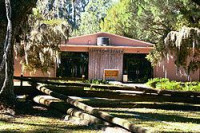|
The present-day state park office in back of the reconstructed breastworks.
Brevet Major Francis Dade’s body was found here along the Fort King Road.
The memorials are placed where Lieutenant Robert Mudge, Major Francis Dade, and Captain Upton Sinclair Fraser’s bodies were found (left to right). The columns are located along the Fort King Road.
Reconstructed breastworks where Captain George Gardiner took command after the initial attack which took the life of Brevet Major Francis Dade. The six-pound cannon was located just outside the breastworks to the left.
Capt. Fraser's body was found here.
Lt. Mudge's body was found here.
The massacre at Dade Battlefield was the fight that initiated the Second Seminole War. Only the massacre of brevet General George Custer and his troops was worse (in terms of numbers killed) in the annals of U.S. military history.
On December 23, 1835, Brevet Major Francis Dade was issued orders to head from Fort Brooke (fort no longer exists but was located in Tampa, FL) along the Fort King Road (only parts of the trail exist today) to Fort King (located in Ocala, FL) to resupply the fort. He had under his command 2 companies of soldiers (108 men) and a six-pound cannon. Dade expected to be attacked in the swamps by the Seminoles between the Hillsborough and Withlacoochee Rivers. Once he passed through the lowlands he relaxed and decided against using flanking scouts along his column.
Chiefs Micanopy, Ote Emathla, and Halpatter Tustenugge (known to Florida settlers as Alligator) and their 177 plus warriors tracked Dade all along his route via scouts and decided to lay in wait near present-day Bushnell, FL. On December 28, the well-concealed Seminoles attacked catching the hapless companies completely by surprise. It is estimated that the first volley took out more than half of the troops including Major Dade who was on horseback. The surviving forward troops fell back to where Captain George Gardiner had assumed command. He immediately ordered the cannon into action quickly returning fire. Gardiner ordered trees felled and an impromptu breastwork was constructed.
Meanwhile, the Seminoles disengaged and regrouped to the northeast. A discussion ensued for more than an hour as to whether they should leave or attack again. Finally, they mustered the courage for another attack which swiftly led to the Seminoles, from well hidden vantage points, picking off the remaining fighting force. They eventually were able to overrun the breastworks and slaughter the wounded. They scalped and stripped the bodies of the soldiers and pushed the cannon into the nearby swamp pond.
Three men escaped but of the three, one was killed on the way back to Fort Brooke by the Seminoles and one later died of his injuries once he reached the fort. The only man to survive, Private Joseph Sprague wounded during the battle, hid in the swamp pond near the battlefield until he could escape under the cover of darkness.

The "Dade Massacre" was an 1835 defeat for the United States Army that greatly escalated the Second Seminole War, which lasted until 1842.






 Please share your ideas with us.
Please share your ideas with us.